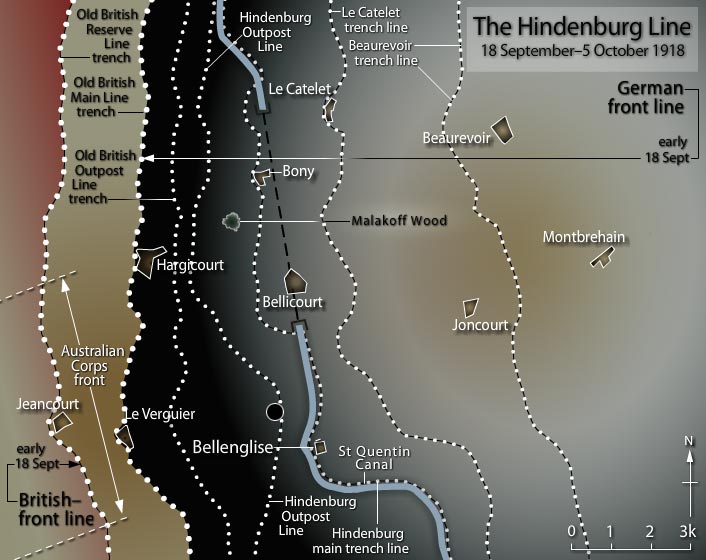Saturday October 5th, 1918
Transferred C Company ?? for line. Bad again with sciatica – cannot walk.
The Hindenburg Line
The Hindenburg Line, constructed in 1916, ran over 100 kilometres between Arras and Laffaux. It comprised four parallel defensive structures. Commonly referred to as ‘lines’, these were the Outpost, Main, Le Catelet and Beaurevoir Lines. Each was a complex of trenches, protected by belts of barbed wire, sometimes 40-metres deep, and pillboxes. These four lines are clearly marked on the following diagram.¹ To the left of these four Hindenburg Lines are three other trench lines. These had been British trenches until the Spring Offensive when they were overrun and captured. Consequently, since March 1918, all seven lines were being held by the Germans, making an eleven kilometre deep fortification.¹

A stretch of the Hindenburg Line (Le Catelet to St Quentin) and Allied Positions, September 18th, 1918*
The above diagram shows the British and German front lines before the British attack of September 18th, 1918. The first of the seven trench lines had been taken by the Allies on September 11th.*
The Hindenburg Line Breached
On September 18th, the Australian Corp’s 1st & 4th Divisions, with British Corps on both flanks, advanced six kilometres to take both the remaining ‘British’ lines and the Outpost line.
The main assault on the Hindenburg line took place on 29 September, exploiting its weakest point around the St Quentin Canal.
Australian, British, French and American forces participated in the attack on the line, which began with a three-day bombardment, using 1,637 guns along a 10,000-yard-long front (in the last 24 hours alone, the British artillery fired almost a million shells). After first capturing the St. Quentin Canal, the Allies successfully breached the Hindenburg Line on September 29.
After four days of heavy fighting with significant casualties on both sides, the Germans were forced to retreat. The following map shows the Allied advance. By October 5th, the final Line, the Beaurevoir, has been breached.¹. Despite this, other parts of the Hindenburg Line remained under German control.

Over the coming month, the Allies will press this hard-won advantage.
It seems as though Frank has been moved to C Coy today. Rebalancing the units within the Battalion will be part of the preparations for moving into the front line.
9th Battalion War Diary – 5th October 1918 – Maricourt
Operation Order No 7 (Appendix No 2) issued at 01:20 hours. Battalion moved to Templeux-la-Fosse. B teams remaining at Moislains. Battalion was at Templeux-la-Fosse by 13:00 hrs.
References & Further Reading
¹ & * Australians on the Western Front on The Anzac Portal
² Allied Forces break through the Hindenburg Line on History.com


